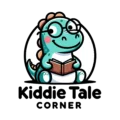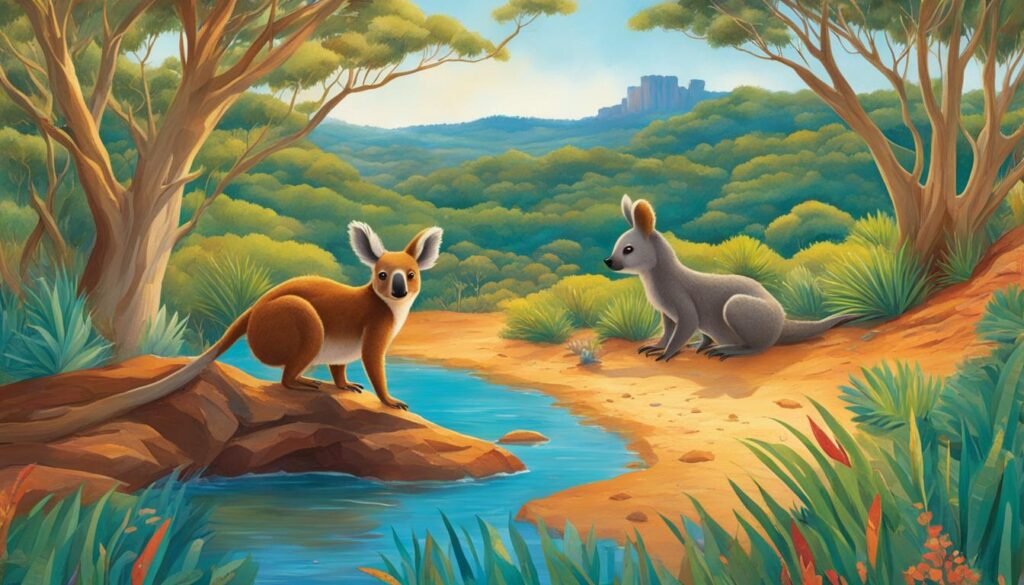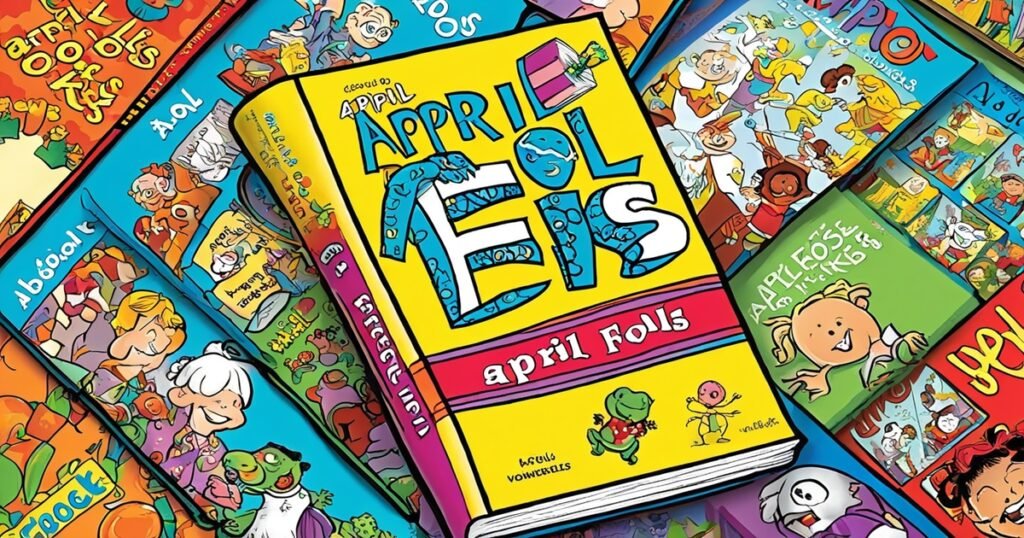Australian kids books have made their mark in the literary world, captivating young readers with their unique blend of storytelling, rich local wildlife, and vivid depictions of Australian landscapes and lifestyle. Renowned books such as “Possum Magic” by Mem Fox and “Diary of a Wombat” by Jackie French intertwine whimsical narratives with authentic Australian settings and characters.
There is no denying the cultural impact these books have made, earning critical acclaim and the love of families worldwide. With their rich stories and vibrant representations of Australia’s diverse landscape and culture, these award-winning titles are a must for the bookshelves of young readers everywhere.
Table of Contents
- Key Takeaways
- A Journey through Australian Children’s Literature
- Australian Kids Books that Every Young Reader Should Try
- A Treasure Trove of Australian Picture Books
- Must-Read Australian Authors for Children
- The Role of Indigenous Tales in Australian Kids Literature
- Exploring the Australian Outback through Children’s Books
- Animal Adventures in Australian Children’s Books
- The Influence of Australian Children’s Book Illustrators
- Australian Kids Books that Tackle Big Issues
- Where to Find Australian Children’s Books
- Conclusion
- Source Links
Key Takeaways
- Australian kids books offer a unique blend of storytelling, cultural representation, and depictions of life in Australia.
- Iconic titles like “Possum Magic” by Mem Fox and “Diary of a Wombat” by Jackie French are beloved for their whimsical narratives set against recognizable Australian landscapes.
- Australian children’s literature has a global appeal, with many books receiving critical acclaim and recognition from prestigious book awards.
- The books provide young readers with an enriching reading experience, offering them a glimpse into the diverse culture and landscape of Australia.
- Australian kids books often serve as a platform for learning and entertainment, making them indispensable for young readers.
A Journey through Australian Children’s Literature
Stepping into the rich tapestry of children’s books Australia offers is akin to embarking on a journey through diverse landscapes, cultures, and narratives. With the unique representation of indigenous stories to acclaimed award-winning titles, Australian children’s literature extends beyond mere storytelling to help young minds understand the importance of cultural representation and diversity in reading.
The Importance of Cultural Representation in Children’s Books
From the Dreamtime tales of the longest surviving culture on Earth to contemporary depictions of Australian society, cultural representation echoes throughout Australian children’s literature. For instance, “The Rainbow Serpent” by Dick Roughsey breathes life into aboriginal creation myths, enlightening readers about the enchanting enigmas of Australia’s millennia-old Aboriginal culture.
Windows and Mirrors: The Diversity of Australian Kid’s Books
Reflecting the multicultural fabric of modern Australia, the rich variety in Australian kid’s books serves as both ‘windows’ and ‘mirrors’. They mirror the experiences of young readers, while the windows provide a deeper understanding of other cultures. “Where the Forest Meets the Sea” by Jeannie Baker, is a prime example, it uses intricate collage illustrations to weave environmental themes that dazzle with their diversity in reading.
A Look at Australian Children’s Book Awards and Recognition
Recognition, in forms of book awards and literary recognition, underscore the global relevance of Australian children’s books. These recognitions not only laud the high-quality storytelling but also uphold the inspirational effect these books have on young minds, shaping future generations with tales of courage, empathy, joy, and a deepened appreciation for diversity.
Australian Kids Books that Every Young Reader Should Try
Engrossing tales from the Land Down Under have found their way into the hearts of readers worldwide, ranking top on the list of best Australian children’s books. These narratives, both timeless classics and contemporary favorites, introduce children to the charm, humor, and wisdom deeply ingrained in the Australian storytelling tradition.
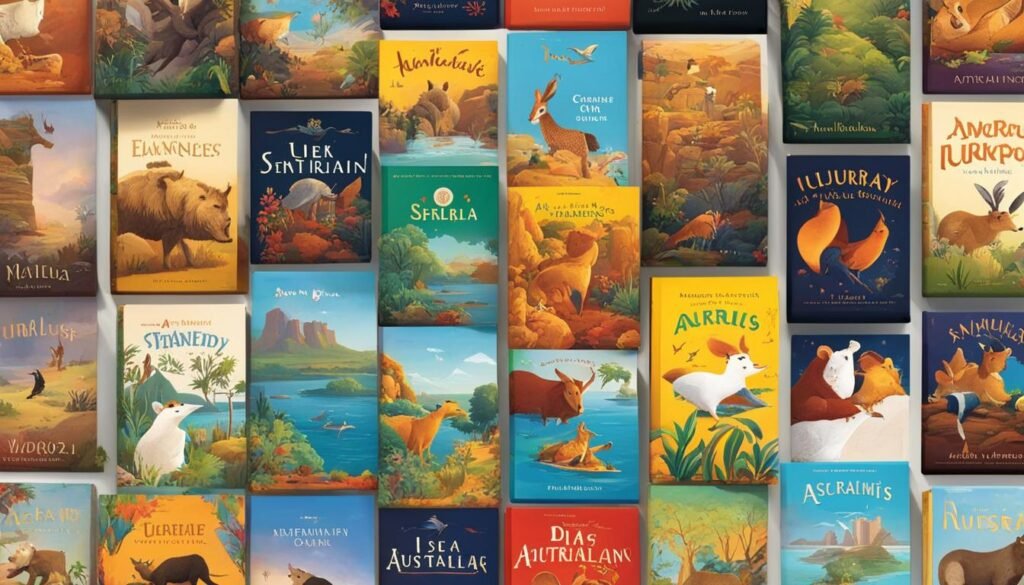
Timeless Classics
Widely regarded as a treasure in children’s literature, some Australian books have stood the test of time, becoming stories passed on to every new generation of readers. Iconic books like “Possum Magic” and “Wombat Stew” have become bookshelf staples, familiar to readers from all walks of life. These timeless classics, infused with Australian lore, impart moral and daily life lessons wrapped up in lovable characters and distinctive settings.
Contemporary Favorites
With the evolving genre, a new wave of authors has emerged, pushing the envelope and exploring themes of resilience, identity and environmental consciousness. One such book, “The First Scientists: Deadly Inventions and Innovations from Australia’s First Peoples” by Corey Tutt gives an insightful glimpse into the contribution of Australia’s First Peoples and their scientific prowess. Bestowed with accolades, these modern classics are creating a space of their own in the realm of contemporary favorites, finding a place in the readers’ preferences round the world.
Whether they are timeless classics or contemporary favorites, popular Australian children’s books offer an invaluable experience to the young readers, inspiring them to envision, learn, and grow.
A Treasure Trove of Australian Picture Books
The realm of Australian picture books is akin to a veritable treasure trove, brimming with enchanting tales and vivid artistry. Distinguished by their vibrant storytelling and vivid illustrations, they serve as an invaluable gateway for young readers, enabling them to envision and learn.
Such books often mark a child’s initial vivid encounter with the world of reading and the captivating culture of Australia. Many of these books are remarkably detailed, with artistic illustrations weaving a compelling narrative that fosters imagination and curiosity in young minds.
Acclaimed illustrators like Bronwyn Bancroft, renowned for her visually dynamic depictions of Australian landscapes, have played an instrumental role in shaping this genre. Bancroft’s work in titles such as “Big Rain Coming” beautifully captures the essence of the Australian landscape with her audacious use of colors, bringing the narratives to life.
Similarly, critically-acclaimed books such as “Where the Forest Meets the Sea,” skillfully use visual storytelling techniques to draw readers into the unique ecosystems of Australia. These tales transport readers, young and old alike, to the heart of Australia’s magnificent wilderness, sparking their interest in this diverse continent.
| Illustrator | Title | Description |
|---|---|---|
| Bronwyn Bancroft | “Big Rain Coming” | A stunning representation of anticipation for the big rain in the arid Australian landscape, capturing the essence of changing weather with vibrant color schemes. |
| Jeannie Baker | “Where the Forest Meets the Sea” | A visual exploration of the beauty of the Great Barrier Reef juxtaposed with the looming threat posed by industrial growth and pollution. |
Regardless of the narrative, one thing is certain: Australian picture books are a treasure trove of Aussie stories that celebrate the nation’s rich history, diverse fauna, unique landscapes, and vibrant culture. They invite young readers on an exploratory journey, fostering a love for reading and a deep appreciation for the arts.
Must-Read Australian Authors for Children
Looking at the vibrant and diverse world of children’s literature, Australian authors significantly stand out, having enriched this literary genre with unique and heartfelt stories. With a rich tapestry of iconic storytellers and dynamic emerging voices, the role of Australian authors in children’s literature is an Engaging exploration.
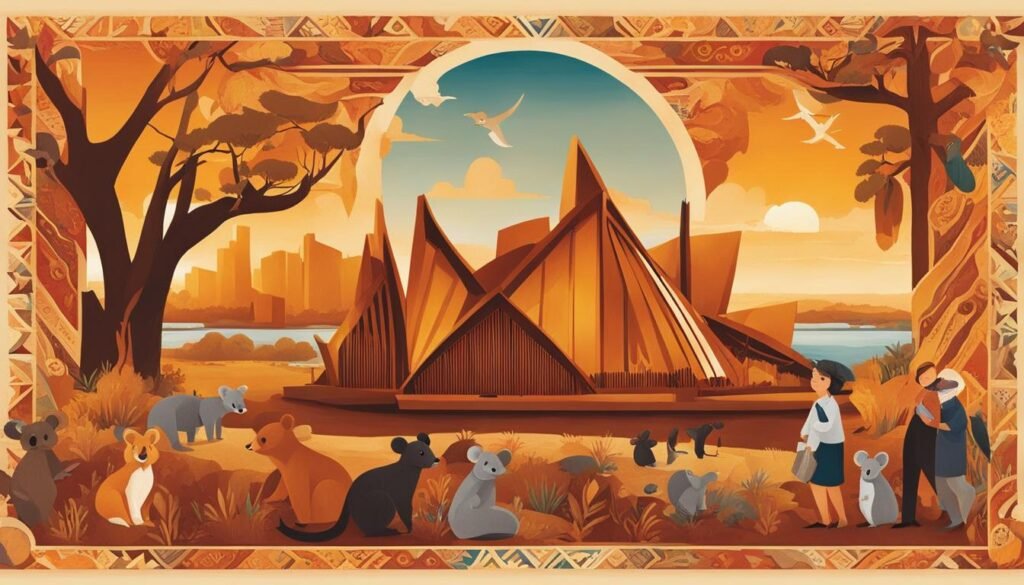
Iconic Storytellers of the Australian Literary Scene
Regarded as the pillars of Australian children’s literature, iconic authors have penned down inimitable tales that have left a long-lasting impact on millions of young readers. Mem Fox, for instance, has become a household name due to her heartwarming tales like “Koala Lou”, which beautifully encapsulate the Australian spirit and culture.
| Author | Renowned Work |
|---|---|
| Mem Fox | Koala Lou |
| Jackie French | Diary of a Wombat |
| Morris Gleitzman | Once |
Emerging Voices in Australian Children’s Books
As the Australian literary scene continually evolves, new authors are emerging with fresh and innovative narratives. These writers are not only contributing to the rich tapestry of Australian children’s literature but are also carrying forward its proud legacy, introducing young readers to distinct tales that beautifully showcase Australia’s unique landscapes and diverse heritage.
| Emerging Author | Notable Work |
|---|---|
| Zanni Louise | Archie and the Bear |
| Adam Goodes and Ellie Laing | Somebody’s Land |
| Meg McKinlay | Duck for a Day |
Be it through timeless fables or fresh, modern narratives, Australian authors have shaped the landscape of children’s literature with their distinct flair for storytelling. Their contribution has not only delighted millions of young readers worldwide but also added to the broad spectrum of international children’s literature in dynamic ways.
The Role of Indigenous Tales in Australian Kids Literature
Indigenous Australian Children’s Books occupy a unique niche in Australian children’s literature, offering an exquisite blend of history, tradition, and cultural richness from the country’s First Nations people. From ancient traditional stories to contemporary narratives, these books present an authentic portrayal of Indigenous cultures, sensitizing young readers to the multifaceted aspects of Australia’s heritage.
Stories from Indigenous Voices
Indigenous voices play an instrumental role in shaping the narrative of Indigenous Australian Children’s Books. From creation stories like “The Rainbow Serpent,” to modern tales of Indigenous life, these narratives offer enriching insights into the Indigenous cultures. Not only are they pivotal in teaching children about Australia’s cultural origins, but they also promote the diversity and richness of the Indigenous cultures.
Teaching Tradition and Land Stewardship
Emphasizing the tenets of land stewardship, many Indigenous Australian Children’s Books convey the importance of respecting the land and its history. Titles such as “Somebody’s Land” by Adam Goodes and Ellie Laing beautifully encapsulate this perspective, highlighting the significant contributions of the Aboriginal and Torres Strait Islander peoples to Australia’s cultural tapestry. These narratives advocate the principles of coexistence and respect towards the land and its caretakers, reinforcing the values of conservation and stewardship in younger generations.
Indigenous Australian Children’s Books thereby, provide a profound source of learning, fostering an appreciation for the indigenous traditions and land stewardship practices amongst young readers. They serve as potent tools in preserving and passing down traditional stories and cultural nuances, allowing these untold narratives to echo through generations, and fostering an understanding and respect of Australia’s rich indigenous heritage.
Exploring the Australian Outback through Children’s Books
The Australian Outback is more than just a geographic location – it’s a vital character that weaves itself into the tapestry of narratives within many children’s adventure books. The vast, rugged landscapes and unique flora and fauna are not merely backdrops for the stories. Instead, they contribute to the exploration narrative, allowing readers to embark on virtual adventures through the distinctive settings of Australia’s heartland.
Consider books like the “Diary of a Wombat” and “Big Rain Coming”. These outback tales provide a glimpse into the daily life and the indomitable spirit of the land. Through these narratives, young readers can experience the Australian Outback’s unique ecology and gain valuable insights into the importance of respecting and preserving these delicate ecosystems.
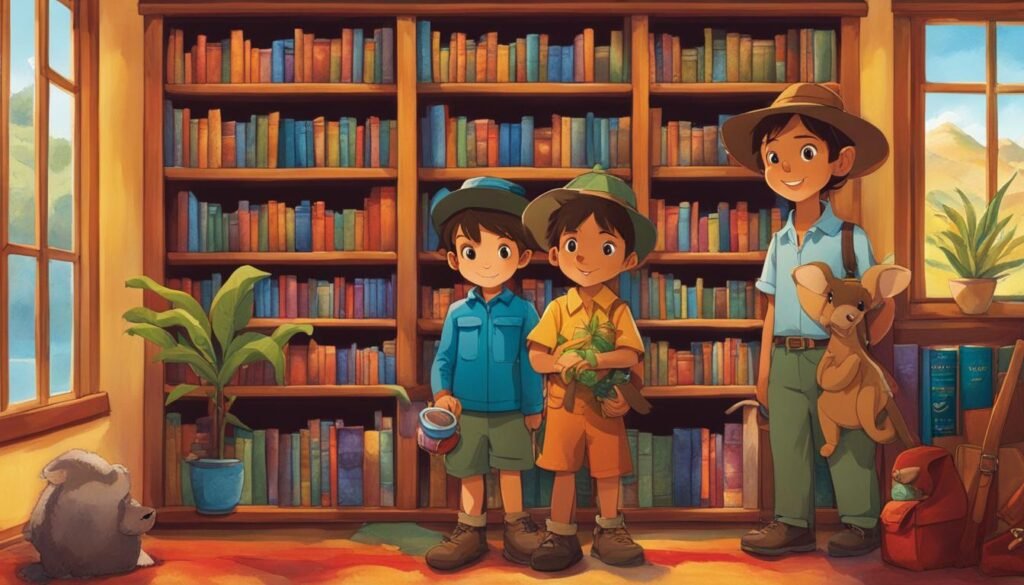
Allow us to delve deeper into this topic by considering some stellar examples of children’s adventure books that skillfully incorporate the Australian Outback into their narratives.
| Book Title | Author | Summary |
|---|---|---|
| “Diary of a Wombat” | Jackie French | This charming tale offers a humorous insight into a day in the life of a wombat, portraying its routine and interactions with humans. |
| “Big Rain Coming” | Katrina Germein | A community in the Outback eagerly waits for the rain to arrive, highlighting the significance of weather events to rural Australian communities. |
| “Are We There Yet?” | Alison Lester | A family embarks on a journey around Australia, capturing diverse landscapes, including the Outback, in this visually enrapturing tale. |
| “Koala Lou” | Mem Fox | Set in the Australian Bush, this heartwarming tale explores themes of family love and resilience. |
In conclusion, the integral role the Australian Outback plays in these children’s adventure books is undeniable. The unique physical features of the Outback not only serve as settings for the stories, but they also contribute to the overall narrative structure, helping to shape the characters’ identities and adventures. By perpetuating an appreciation for Australia’s natural beauty, these books inspire a generation of conscious and informed young readers.
Animal Adventures in Australian Children’s Books
Exploring the vibrant world of Australian children’s books, one evident charm is the delightful animal adventures that abound. These works provide interactive and educative avenues for young readers to learn about the unique wildlife that marks the continent.
Learning About Wildlife with Australian Characters
From the outlands of the outback to the sprawling coastal zones, authors utilize wildlife characters to paint an engaging and illustrative narrative of these regions. Works like Mem Fox’s “Possum Magic” and “Diary of a Wombat” provide stellar examples where the distinct attributes of Australia’s fauna are brought to life. Children are introduced to the enchanting world of Australian animal stories through the experiences of characters like Hush the Possum and the cheeky wombat.
Character-Driven Animal Tales from Australia
Beyond the educational aspect, these character-driven narratives prove to be entertaining, spinning yarns of remarkable adventures that captivate young minds. More crucially, they emphasize the beauty of Australia’s biodiversity. Through tales focused on environmental conservation and understanding natural habitats, young readers gain insights into the importance of preserving these unique creatures and the ecosystems they call home.
| Books | Animals Featured | Lessons Learnt |
|---|---|---|
| Possum Magic | Possum | Bravery, Resilience |
| Diary of a Wombat | Wombat | Persistence, Curiosity |
| Koala Lou | Koala | Self-esteem, Love |
In summary, the wonderfully diverse and exciting realm of Australian wildlife is truly a central theme in Australian children’s literature. It speckles the story landscape with Spritely characters and gripping narratives, thrilling the minds of young readers as they journey through the lush, vibrant world of Australian fauna.
The Influence of Australian Children’s Book Illustrators
One of the mesmerizing elements in children’s books is the art that accompanies the written word – the enchanting pictures that weave the story visually. Notable Australian children’s book illustrators such as Julie Vivas, Bruce Whatley, and Liz Anelli have made significant contributions to this field of illustrative artistry. By enriching children’s book art with their unique and creative vision, these illustrators figuratively open doorways to diverse and magical worlds.
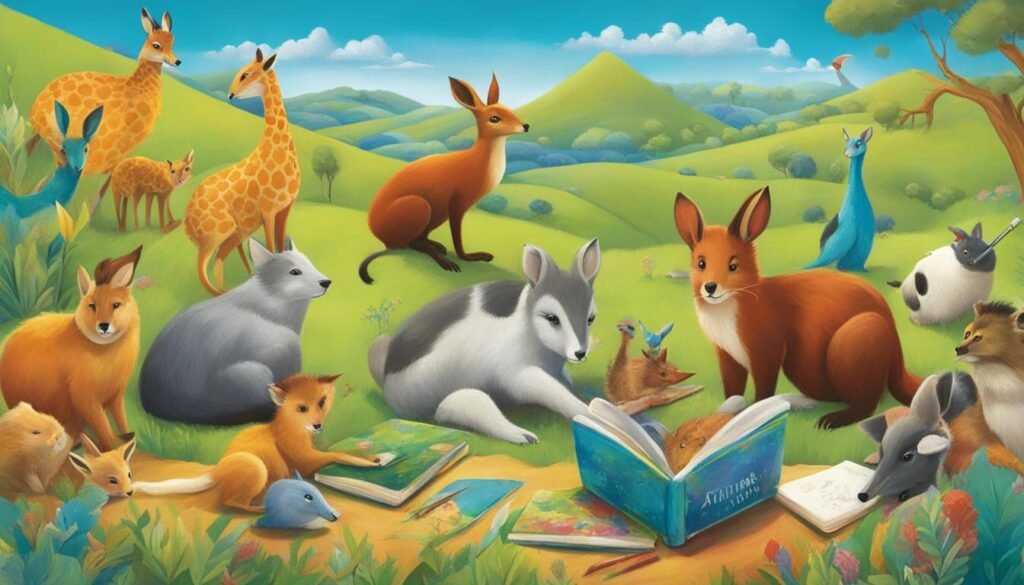
Remember the captivating visuals of “Possum Magic”? These illustrations have styled the memories of so many readers over the years, becoming as iconic as the story itself. Through the power of visual storytelling, these illustrators have seized the wonderful opportunity to mold the aesthetics of a child’s early reading experience, setting the visual rhythm that children follow while getting lost in their favorite stories.
“The impact of illustrators in Australian children’s books is profound, as they set the visual tone and meter of the stories, providing the first >interaction children have with the art form of illustration.”
| Illustrator | Significant Works |
|---|---|
| Julie Vivas | “Possum Magic”, “Wilfrid Gordon McDonald Partridge” |
| Bruce Whatley | “Diary of a Wombat”, “The Ugliest Dog in the World” |
| Liz Anelli | “Desert Lake”, “Dry to Dry: The Seasons of Kakadu” |
From capturing the charm of the Australian outback, portraying the unique characteristics of Aussie wildlife, to handsomely presenting themes of cultural importance, Australian children’s book illustrators have significantly influenced how stories are perceived and have exponentially enhanced the narrative experience.
Australian Kids Books that Tackle Big Issues
Australian children’s literature is more than a medium for entertaining narratives. It has become a crucial tool for addressing significant, real-world issues that affect society and the environment, thereby shaping young minds and raising their awareness on these essential subjects. The following subsections elaborate on how these books delve into these crucial topics.
Addressing Social Themes
Particularly noteworthy in the Australian children’s book industry is the effort to educate young readers about prominent social themes. By illustrating scenarios that discuss racism, cultural diversity, and inclusivity, these books provoke thought and foster empathy. Notable works such as ‘Who’s Afraid of the Light?’ and ‘Nothing Alike’ explicit these central themes, chronicling stories that showcase the richness of social diversity and the importance of equality.
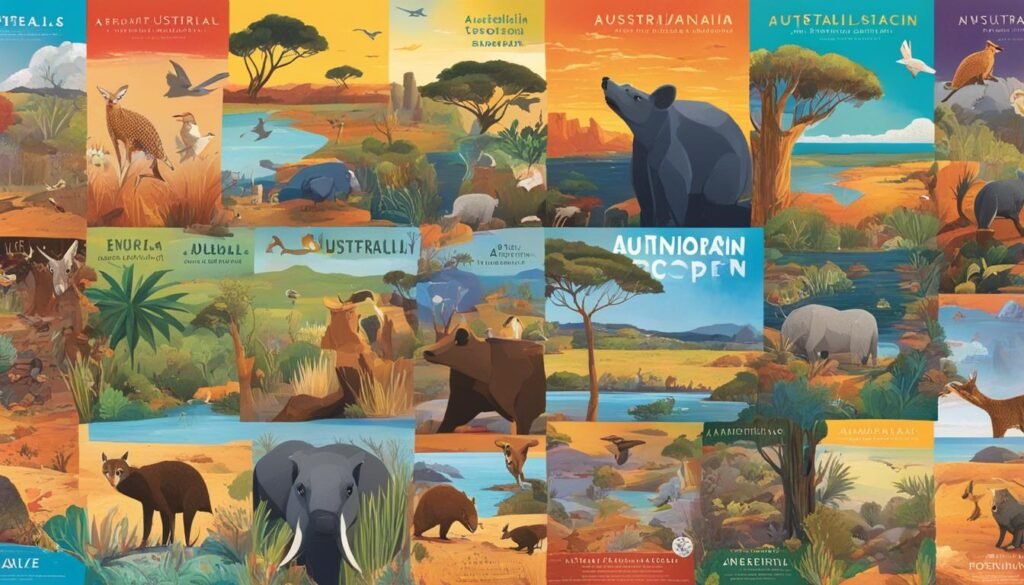
Environmental Concerns in Children’s Storytelling
Amid rising concerns over the state of our planet, Australian children’s books have not shied away from addressing environmental issues. These books highlight quintessential principles of ecosystem preservation, wildlife protection, and sustainability, using compelling narratives and characters that stir the interest of young readers. For instance, many stories underscore the importance of trees, the threats faced by the Great Barrier Reef, or the delicate balance of the Australian Outback’s ecosystem. These narratives are instrumental in fostering a sense of environmental stewardship among their readers.
In summary, it’s evident that tackling big issues in kids books has become a defining characteristic of Australian children’s literature. By addressing social themes and spotlighting environmental concerns, these books cultivate a heightened sense of awareness and empathy among young readers, equipping them with the understanding necessary to become responsible global citizens.
Where to Find Australian Children’s Books
Australian children’s books bring life to the tales of a beautiful and diverse continent. Their enchanting narratives stimulate the imaginations of young readers worldwide. Quenching this thirst for Australian stories can seem daunting for international readers, but luckily, countless avenues make these treasured tales accessible across the globe. Here’s a guide to help you navigate your way towards these rich literary resources.
A Guide to Australian Children’s Book Publishers
The first port of call for those seeking Australian titles are the publishers themselves. Renowned Australian children’s book publishers have catalogs that capture the breadth and depth of Australian storytelling. Among them, the likes of Lothian Children’s Books, Walker Books Australia, and Magabala Books stand out for their diverse and high-quality selections.
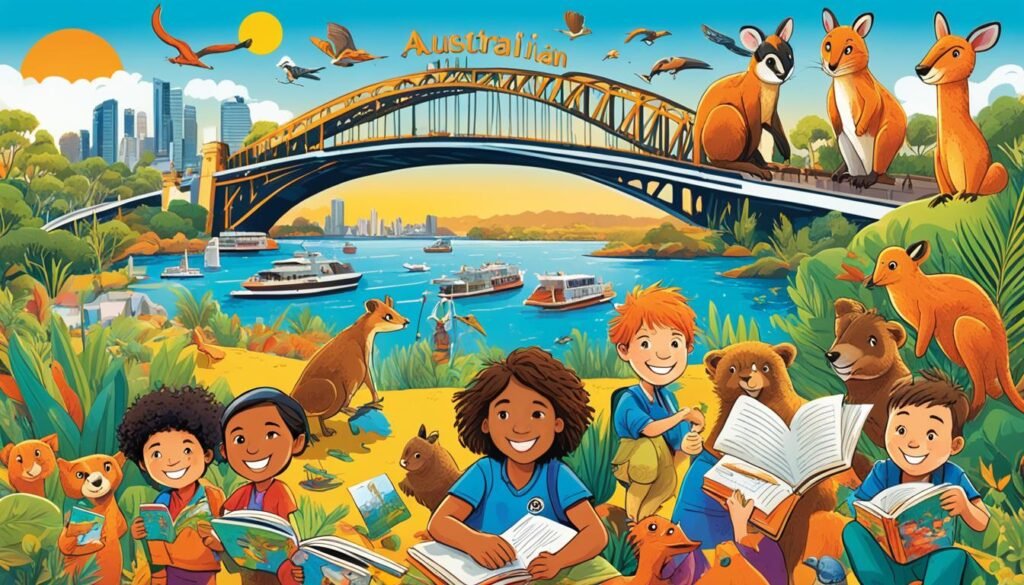
| Publisher | Notable Publications |
|---|---|
| Lothian Children’s Books | “The Spotty Dotty Daffodil” by Rosemary Wilson, illustrated by Anil Tortop |
| Walker Books Australia | “Blinky Bill” by Dorothy Wall |
| Magabala Books | “Baby Business” by Jasmine Seymour |
Resources for International Readers Seeking Australian Titles
For international readers in pursuit of Australian titles, online marketplaces and literary resources open up a world of opportunities. Platforms like Goodreads serve as comprehensive guides, featuring reviews and recommendations to aid your book selection. Furthermore, international library networks often have links for book acquisition, ensuring that the joy and lessons contained within these Australian pages extend beyond borders.
Let’s revel in the beauty of Australian children’s literature, abundant in cultural richness and imaginative storytelling. Whether you’re in Australia or halfway around the world, getting your hands on these delightful reads is merely a few clicks away.
Conclusion
Embarking on a literary journey through Australian kids books is more than just an exploration of captivating stories. It’s an enriching experience that immerses young readers in tales of diversity, culture, and the breathtaking beauty of the Australian landscape. These books not only weave enthralling narratives, but they also impart essential life lessons that resonate with children worldwide.
From the unforgettable classics, like “Possum Magic” and “The Rainbow Serpent”, to the innovative narratives penned by contemporary authors, these books foster a deep appreciation for the vast and splendid Australian environment and its unique inhabitants. The vibrant visions of the skilled illustrators further enhance the storytelling, offering a visual treat that engulfs readers in the mood and tone of the tales.
Whether it’s the enchanting animal adventures, the invaluable lessons on social themes and environmental concerns, or the exploration of the Indigenous culture, Australian children’s books succeed in offering something meaningful for every young reader. Through their charm and educational value, these books have secured their place in the heart of global literature, paving the way for a rich and rewarding reading journey for generations to come.
FAQ
What are some of the best Australian kids books?
Some of the most recognized and loved Australian children’s books include titles like “Possum Magic” by Mem Fox, “Diary of a Wombat” by Jackie French, “Where the Forest Meets the Sea” by Jeannie Baker, and “The Rainbow Serpent” by Dick Roughsey. These books present unique stories set in the vibrant Australian landscapes and boast rich cultural narratives.
How do Australian children’s books highlight cultural representation?
Australian Children’s Literature has made a significant impact in highlighting indigenous tales and characters, and offering narratives deeply rooted in Australia’s diverse cultural heritage. These books act as both ‘windows’ and ‘mirrors,’ allowing young readers to see their own experiences reflected while also learning about other cultures, lifestyles, and perspectives.
What are the timeless classics and contemporary favorites in Australian children’s books?
There are a plethora of timeless classics and contemporary favorites that captivate young readers. Classics like “Possum Magic” and “Wombat Stew” have become children’s literature staples, while newer titles like “The First Scientists: Deadly Inventions and Innovations from Australia’s First Peoples” by Corey Tutt are being recognized for their innovative narratives and educative themes.
Who are some of the notable Australian children’s book illustrators?
Australian children’s book illustrators like Julie Vivas, Bruce Whatley, and Liz Anelli play a vital role in enriching stories with their creative and captivating artwork. Their illustrations not only complement the narratives but also influence a child’s imagination and understanding of the plot and characters.
Can you name some indigenous tales that hold significance in Australian children’s literature?
Indigenous tales like “The Rainbow Serpent” by Dick Roughsey and “Somebody’s Land” by Adam Goodes and Ellie Laing play a significant role in representing the rich tradition, history, and stories of the First Nations people. Such books lend authenticity to the representation of Indigenous cultures and ensure their strong presence in children’s literature.
Where can one find Australian children’s books?
Australian children’s books can be found and ordered through various sources. Local bookstores and renowned Australian children’s book publishers like Lothian Children’s Books, Walker Books Australia, and Magabala Books offer them, and for readers around the world, online marketplaces and literary networks like Goodreads provide access to these books.
Do Australian children’s books also address significant social and environmental issues?
Absolutely, Australian children’s books are known to tackle big issues affecting social and environmental landscapes. By exploring significant themes like racism, diversity, inclusiveness, ecosystem preservation, and sustainability, these stories play a key role in educating young readers about these critical topics and creating a socially aware generation.
